|
Thurs., April 19
1:00 p.m.
ALCPG ILC Physics and Detector Seminar - Hornets' Nest, WH-8 X-Over
Speaker: M. Stoye, CERN
Title: Alignment with Tracks in CMS
2:30 p.m.
Theoretical Physics Seminar - Curia II
Speaker: B. Holdom, University of Toronto
Title: A Simple-Minded Guess for the LHC: a Fourth Family
3:30 p.m.
DIRECTOR'S COFFEE BREAK - 2nd Flr X-Over
4:00 p.m.
Accelerator Physics and Technology Seminar - 1 West
Speaker: L. Rossi, CERN
Title: LHC Commissioning and Status
Fri., April 20
3:30 p.m.
DIRECTOR'S COFFEE BREAK - 2nd Flr X-Over
4:00 p.m.
Joint Experimental-Theoretical Physics Seminar - 1 West
Speaker: D. Waters, University College London
Title: Measurement of the W Width at CDF
Click here for NALCAL,
a weekly calendar with links to additional information. |
Thursday, April 19
-Southwestern chicken tortilla
-Philly style cheese steak
-Garlic herb roasted pork
-Tomato basil chicken parmesan
-Southwestern turkey wrap
-Assorted pizza slices
-Marinated grilled chicken Caesar salad
Wilson Hall Cafe Menu |
Thursday, April 19
Dinner
- Field greens w/ pears and shaved parmesan
- Chilean sea bass w/ white wine butter sauce
- Steamed asparagus
- Lemongrass rice
- Chocolate soufflé w/Amaretto crème anglais
Wednesday, April 25
Lunch - Closed
Chez Leon Menu
Call x4598 to make your reservation. |
|
|
Rare Peregrine pair spotted:
Are they resting or nesting?
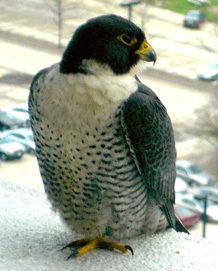
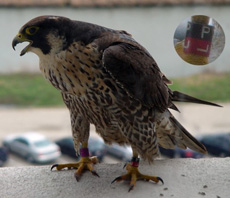
Male and female Peregrine falcons have been spotted at Wilson Hall.
Two rare birdies sitting in a tree,
K-I-S-S-I-N-G. . .
They might not actually kiss. But Fermilab's avian expert and Accelerator Division physicist Peter Kasper hopes that love is in the air for a pair of Peregrine falcons spotted at the upper heights of Wilson Hall.
"They are certainly behaving that way -- they are acting like a mated pair," said Kasper, who said he's seen the pair since the middle of March. Typically gray or brown in color with long, pointed wings and a short, dark hooked beak, Peregrine falcons are extremely rare and are in danger of extinction as a breeding species in Illinois. If the birds do nest, they would represent the first breeding record in DuPage County.
"Peregrine falcons like cliffs," said Kasper. "We don't really have cliffs in DuPage County, but the tall building at Fermilab looks like a good cliff to them."
Through the colors and numbers on the female's leg band, which is black over red, she was recently identified as Naomi Jo, a one-year-old who hatched in Bedford, Trimble County, Kentucky on March 16, 2006. The identity of her mate, however, remains unknown. Kasper is hoping to learn more through the letters on the male's leg band, which is colored black over green and is on his left leg. "I need to know what the letters are on his leg band," said Kasper. "If someone can get a photo in which the bird's leg is visible I could find out where he is from and who he is."
Although he isn't sure if the birds will nest this year, Kasper has noticed the birds exhibiting mating behaviors, including cooperative hunting. If the birds do nest, Kasper expects it will be on the roof of Wilson Hall or on a quiet ledge outside an unused window. Anyone who spots a nest or has a photo of the male's leg band can contact Peter Kasper via email. For more information on the falcon pair, visit the Falcon page of Kasper's Birds of Fermilab web site.
-- Rhianna Wisniewski
|
Scout's Honor
 Fourth graders from Cub Scout Pack 394 earned their engineering badges at Fermilab last weekend.
Fourth graders from Cub Scout Pack 394 earned their engineering badges at Fermilab last weekend.
Keeping a 10-year-old boy's interest can be difficult, but the folks at Fermilab made it simple last Saturday by helping fourth-grade scouts build catapults and electric circuits.
A group of 12 Cub scouts from Pack 394 in Schaumburg visited Fermilab last weekend to meet requirements for their engineering badge, one of two badges offered at Fermilab.
Both the engineer and scientist badges usually require talking to an engineer or scientist to learn about that profession, and then learning about important elements of each profession through hands-on experiments. The scouts from Pack 394 created catapults from coat hangers and spoons, built simple electrical circuits with a switch, flashlight battery and light, and used Fermilab's surveying tools to measure the lengths and widths of the 15th floor.
"The boys had so much fun. They really enjoyed making electrical circuits, catapults and the view from the 15th floor," said Cubmaster Peter Bruno.
Susan Sheehan, who schedules the scouting events, said the Lederman Science Education Center has offered the opportunity to scouting troops for more than five years. She said that the scientist badge is more popular -- packs visit the lab for that badge every week, and about once a month for the engineering badge.
-- Rhianna Wisniewski
|
Open Science Grid: Living up to the Name
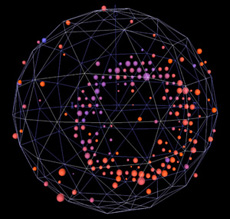
A neutrino event recorded by the MiniBooNE experiment. The ring of light, registered by some of more than one thousand light sensors inside the detector, indicates the collision of a muon neutrino with an atomic nucleus.
The Open Science Grid, supported by the U.S. Department of Energy's Office of Science and the National Science Foundation, works hard to live up to its name: OSG is a grass roots consortium open to all scientific communities, accommodating to all resource providers, open to new technologies and to integration and interoperability with other grids. OSG supports science and research-especially collaborative science requiring high throughput computing. OSG enables the sharing of distributed computing and storage resources by connecting them into a common grid infrastructure over production and research networks via a common set of middleware.
Read More
|
Ledger-Enquirer.com
April 17, 2007:
(McClatchy Newspapers)
U.S. losing its lead in a vital branch of physics
WASHINGTON - The United States is losing its lead in high-energy physics, a field of science it's dominated since the 1930s.
Scientists say Europe is now in the vanguard of a worldwide search to discover the deepest secrets that Mother Nature hides in bits and pieces of atoms.
At least 15 years, probably more, will pass before American physicists lead the pack again.
Particle physics, as the field is called, lies at the heart of all modern science. Particle researchers explore the nature of space and time, matter and energy, the basic building blocks of the universe.
Read More |
|
|
Focusing on the Top Quark
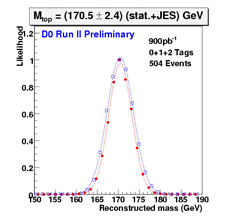
The Matrix Element analysis method allows the measurement of the most likely top-quark mass. This figure shows the likelihood as a function of top-quark mass for the electron plus jets selection (red dots). A similar analysis is performed for the muon plus jets selection (blue squares), thus improving the precision of the mass measurement.
The Tevatron stands as the only place in the world to study top quarks. Over the past ten years, enormous effort has gone into measuring the top quark's mass. Because it's so heavy (roughly twice the mass of W and Z bosons), the top quark can tell us much about how matter behaves and how the universe has evolved.
After so much study, one might ask Tevatron physicists, "Why is measuring the top mass so difficult?" Their resounding answer would be, "Resolution." For example, imagine trying to read a distant road sign through a very dirty windshield. Under such conditions, it might be difficult to resolve what is written on the sign. And if you're not exactly sure where you're going, reading many blurred signs could get you totally lost. One way to improve your focus is to estimate just how much each sign is being blurred and correct the image accordingly. This is exactly what physicists at the DZero experiment do when they measure the top quark mass.
When top quarks are created in Tevatron collisions, they almost immediately decay into a bottom quark and a W boson. Top quarks are generally produced in pairs and the W boson also decays into two more particles, for a total of six particles. With subsequent decays of the b quarks, and a neutrino or two sneaking momentum away from the system, the picture gets fuzzy very quickly! Add a bit of uncertainty on the measurement of all six particles and the exact mass of the top quark looks hopelessly blurred. Scientists in the DZero collaboration improve their ability to resolve the top quark mass by using predictions of the different ways to produce top quark pairs and how they might be blurred. Called the "Matrix Element Method," this technique allows physicists to compare each event to many different possible final states. By varying the hypothesized top quark mass, physicists can determine the most likely mass for their observed top quark decays.
DZero has recently reported a measurement of the top quark mass in the lepton (electron or muon) plus jets final state. In 0.9 inverse femtobarns of data, they found a mass of 170.5 ± 2.7 GeV/c^2 using the Matrix Element Method. This new top-mass measurement pushes the precision of the world-average top quark mass to one percent. It just goes to show what DZero scientists can do when they are focused on the top quark.
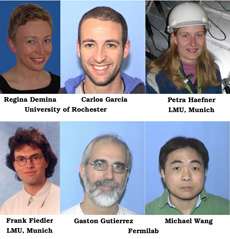
The DZero top quark group is charged with measuring a range of top quark properties, including its mass. This photo shows the principals involved in the lepton-plus-jets analyses.

The challenging job of DZero run coordinator is shared by two senior DZero detector experts. Taka Yasuda (right) is passing the torch to Norm Buchanan (left) after more than two years of dedicated service. Norm joins Bill Lee (center) in the task of ensuring that DZero continues to meet the highest standards in efficiency and data quality.
|
|
Pine Street entrance closing:
Use Wilson Street entrance
Both the in-and-outbound lanes of Fermilab's Pine Street entrance will be closed during paving operations next week, from Monday, April 23 to Thursday, April 26. All operations are dependent on the weather. Roads and Grounds crews do not expect that the Pine Street entrance closing will affect bicyclists entering the lab. However, bicyclists who want to ride through on Pine street will have to turn off at the Lederman Science Education Center and then cross over on the trail to the Wilson Hall west parking lot. Employees and visitors who would normally enter lab grounds at Pine Street should use the Wilson Street entrance. The Pine Street entrance will be open again in the evenings once paving has finished for the day. Fermilab Today will provide updates.
Monthly Leave Sheets Due Tomorrow
Monthly Leave Sheets are due in Payroll by 10 a.m. on Friday, April 20
Enstore system Stken and D0en down today
The Enstore system Stken and D0en will be down today between 7 a.m. and noon for fire supression testing. The D0en instance should be back up by 9 a.m. Stken will also receive hardware and software updates and should be back up by noon.
Please contact us via email with any questions.
Users' Office closings
The Users' Office will be closed on Thursday, April 19, and Friday, April 20. Please renew IDs or contact the Users' Officer before the closing dates. To renew your ID while the office is closed, visit the Key &ID office for a visitor's pass and access card for site access and shift work. New employees may receive a visitor's pass only from the Key & ID office for site access. For car rentals, please contact Enrique Lopez at 847-707-3643 or 630-840-4037. In an emergency, you may contact Borys Jurkiw at 630-840-4363 or by email.
Administrative Professionals Day celebration
On Friday, April 20, at 2:30 p.m. in One West, Fermilab's administrative staff will celebrate Administrative Professionals Day by learning "How Men and Women View the Art and Power of Negotiating." The featured speaker is Malou Roth, recipient of the 2000 Optimas Award for Global HR presented by "Workforce" magazine. She is currently an HR Consultant and former VP of International HR for Molex Inc. Her presentation will focus on the differences in how men and women approach negotiating. She will also explore the how our beliefs originate and how they are reinforced as we grow up, engage in play, go to school, and enter the workforce. Refreshments will precede the presentation at 2:00 p.m. in Wilson Hall, One West. Mark your calendars now to attend this informative session.
|
|